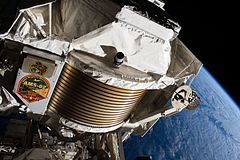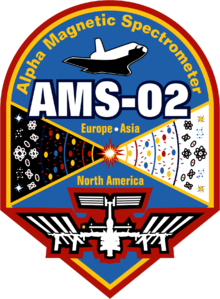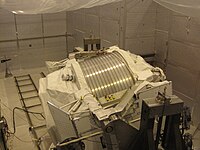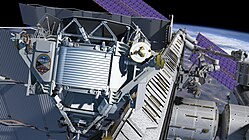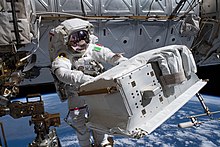
In modern physics, antimatter is defined as matter composed of the antiparticles of the corresponding particles in "ordinary" matter, and can be thought of as matter with reversed charge, parity, and time, known as CPT reversal. Antimatter occurs in natural processes like cosmic ray collisions and some types of radioactive decay, but only a tiny fraction of these have successfully been bound together in experiments to form antiatoms. Minuscule numbers of antiparticles can be generated at particle accelerators; however, total artificial production has been only a few nanograms. No macroscopic amount of antimatter has ever been assembled due to the extreme cost and difficulty of production and handling. Nonetheless, antimatter is an essential component of widely available applications related to beta decay, such as positron emission tomography, radiation therapy, and industrial imaging.

Particle physics or high-energy physics is the study of fundamental particles and forces that constitute matter and radiation. The field also studies combinations of elementary particles up to the scale of protons and neutrons, while the study of combination of protons and neutrons is called nuclear physics.

The positron or antielectron is the particle with an electric charge of +1e, a spin of 1/2, and the same mass as an electron. It is the antiparticle of the electron. When a positron collides with an electron, annihilation occurs. If this collision occurs at low energies, it results in the production of two or more photons.

Cosmic rays or astroparticles are high-energy particles or clusters of particles that move through space at nearly the speed of light. They originate from the Sun, from outside of the Solar System in our own galaxy, and from distant galaxies. Upon impact with Earth's atmosphere, cosmic rays produce showers of secondary particles, some of which reach the surface, although the bulk are deflected off into space by the magnetosphere or the heliosphere.

The antiproton,
p
, is the antiparticle of the proton. Antiprotons are stable, but they are typically short-lived, since any collision with a proton will cause both particles to be annihilated in a burst of energy.

Samuel Chao Chung Ting is an American physicist who, with Burton Richter, received the Nobel Prize in 1976 for discovering the subatomic J/ψ particle.

PAMELA was a cosmic ray research module attached to an Earth orbiting satellite. PAMELA was launched on 15 June 2006 and was the first satellite-based experiment dedicated to the detection of cosmic rays, with a particular focus on their antimatter component, in the form of positrons and antiprotons. Other objectives included long-term monitoring of the solar modulation of cosmic rays, measurements of energetic particles from the Sun, high-energy particles in Earth's magnetosphere and Jovian electrons. It was also hoped that it may detect evidence of dark matter annihilation. PAMELA operations were terminated in 2016, as were the operations of the host-satellite Resurs-DK1. The experiment was a recognized CERN experiment (RE2B).
Alexandru Adalbert "Alex" Marin was an American experimental particle physicist, a professor of physics at MIT, Boston University and Harvard University, and a researcher at CERN and JINR.
Astroparticle physics, also called particle astrophysics, is a branch of particle physics that studies elementary particles of astrophysical origin and their relation to astrophysics and cosmology. It is a relatively new field of research emerging at the intersection of particle physics, astronomy, astrophysics, detector physics, relativity, solid state physics, and cosmology. Partly motivated by the discovery of neutrino oscillation, the field has undergone rapid development, both theoretically and experimentally, since the early 2000s.
The Particle Astrophysics Magnet Facility is a NASA project that was designed to investigate anti-matter. It consisted of a series of experiments which would culminate in an experiment launched in 1995 to be externally attached to the Freedom Space Station
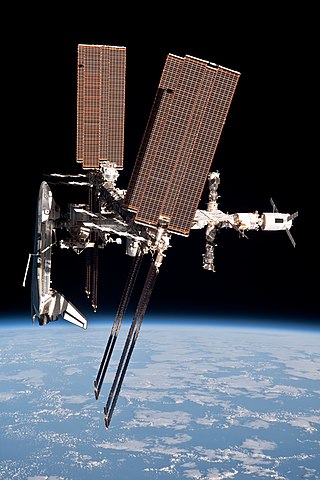
STS-134 was the penultimate mission of NASA's Space Shuttle program and the 25th and last spaceflight of Space ShuttleEndeavour. This flight delivered the Alpha Magnetic Spectrometer and an ExPRESS Logistics Carrier to the International Space Station. Mark Kelly served as the mission commander. STS-134 was expected to be the final Space Shuttle mission if STS-135 did not receive funding from Congress. However, in February 2011, NASA stated that STS-135 would fly "regardless" of the funding situation. STS-135, flown by Atlantis, took advantage of the processing for STS-335, the Launch on Need mission that would have been necessary if the STS-134 crew became stranded in orbit.
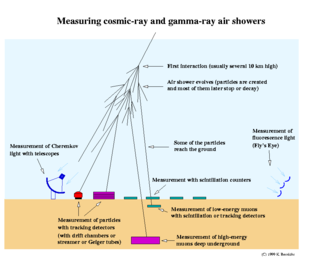
A cosmic-ray observatory is a scientific installation built to detect high-energy-particles coming from space called cosmic rays. This typically includes photons, electrons, protons, and some heavier nuclei, as well as antimatter particles. About 90% of cosmic rays are protons, 9% are alpha particles, and the remaining ~1% are other particles.

Colonel Luca Parmitano is an Italian astronaut in the European Astronaut Corps for the European Space Agency (ESA). He was selected as an ESA astronaut in May 2009. Parmitano is also a Colonel and test pilot for the Italian Air Force. He is the first Italian to command the International Space Station (ISS) during Expedition 61.

The CALorimetric Electron Telescope (CALET) is a space telescope being mainly used to perform high precision observations of electrons and gamma rays. It tracks the trajectory of electrons, protons, nuclei, and gamma rays and measures their direction, charge and energy, which may help understand the nature of dark matter or nearby sources of high-energy particle acceleration.

The Antihydrogen Laser Physics Apparatus (ALPHA), also known as AD-5, is an experiment at CERN's Antiproton Decelerator, designed to trap antihydrogen in a magnetic trap in order to study its atomic spectra. The ultimate goal of the experiment is to test CPT symmetry through comparing the respective spectra of hydrogen and antihydrogen. Scientists taking part in ALPHA include former members of the ATHENA experiment (AD-1), the first to produce cold antihydrogen in 2002.
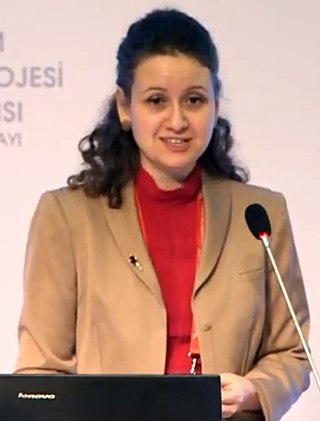
Bilge Demirköz is a Turkish professor of high energy physics at Middle East Technical University. She coordinates the Particle Radiation Tests Creation Laboratory, the first collaboration between Turkey and CERN, the European Organization for Nuclear Research.

Expedition 61 was the 61st Expedition to the International Space Station, which began on 3 October 2019 with the undocking of the Soyuz MS-12 spacecraft. The Expedition was commanded by ESA astronaut Luca Parmitano, who became the third European and first Italian astronaut to command the ISS. Parmitano, along with his Soyuz MS-13 colleagues Aleksandr Skvortsov and Andrew Morgan, and Christina Koch from Soyuz MS-12, transferred over from Expedition 60. They were joined by Oleg Skripochka and Jessica Meir, who launched on 25 September 2019 on board Soyuz MS-15.
Eun-Suk Seo is a Korean-American astrophysicist known for her observational research on cosmic rays. She is a professor of physics at the University of Maryland, College Park, where she is also affiliated with the Institute for Physical Science and Technology and heads the Cosmic Ray Physics Group.

Roberto Battiston is an Italian physicist, specialized in the field of fundamental physics and elementary particles, and leading experts in the physics of cosmic rays. He was the president of the Italian Space Agency (ASI) from 2014 to 2018 and president of the Italian National Institute for Nuclear Physics (INFN) Committee on Astroparticle Physics from 2009 to 2014.
Cosmic ray astronomy is a branch of observational astronomy where scientists attempt to identify and study the potential sources of extremely high-energy charged particles called cosmic rays coming from outer space. These particles, which include protons, electrons, positrons and atomic nuclei, travel through space at nearly the speed of light and provide valuable insights into the most energetic processes in the universe. Unlike other branches of observational astronomy, it uniquely relies on charged particles as carriers of information.
